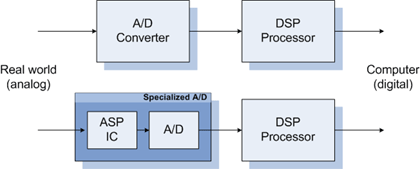


We assume the typical model of signals coming from real-world sensors, which are analog in nature, that need to be utilized by digital computers. The inverse problem, digital signals going to real-world actuators, is similar in nature. One approach is to put an analog-to-digital (A/D) converter as close to the sensor signals as possible, and allow the remainder of the computations to be performed digitally. An alternate approach is to perform some of the computations using analog signal processing, requiring simplier A/D converters, and reducing the computational load of resulting digital processors. One could group this analog computation and A/D converter as a specialized A/D converter that gives more information (Fourier coeffcients, phonems, etc.) than a literal map of the incoming signal. The question of where to put this boundry line strongly depends upon the particular requirements of an application.
We define cooperative analog-digital signal processing (CADSP) as looking at the issues of using combinations of programmable analog signal processing and digital signal processing techniques for real world processing. Neither analog signal processing or digital signal processing can exist in current technologies without the other; that is, real-world signals are analog while much of the modern control and communication is digital. In the end, the question is where to partition the analog-digital boundry, as shown in Figure 1, to enhance the overall functionality of a system by utilizing analog/digital computations in mutually bene cial way. CADSP allows freedom of movement for the partition between the analog and digital computation. CADSP is a superset of mixed-signal research in that it focuses heavily on algorithms as well as circuit implementation. By adding functionality to our analog systems, we enhance the capabilities of the controlling digital system, and therefore, the entire product under consideration.
A full discussion of this partition problem can and will encompass several research papers [3][2][1][6]. The range of applications for these approaches reaches from auditory and speech processing, to beam-forming, multidimensional signal processing, and radar computations, communications processing, and image processing and recognition.
One might wonder why we introduce analog signal processing, since the current framework of immediately digitizing the incoming signal, illustrated as the top half in Figure. 1, seems to be working well in current practice, primarily being driven by transistor scaling and flexibilty of programmability. First, the increasing proliferation of portable electronics has increased emphasis on low-power systems. Functionality, and therefore the amount of signal processing, is often primary constrained fixed power budget, not just simply possible performance; often a project will die if the power budget is too high. A custom analog approach can achieve an increased efficiency (= Bandwidth * Power) by 10^4 over a custom digital approach [17], which could enable many applications years ahead of schedule from a purely digital roadmap. This increase in efficiency can be used for reducing the power efficiency of a given problem, or addressing computational problems that are considered intractable by the current digital roadmap. Second, the system demands on current systems require very high resolution / high performance A/D converters; the resulting A/D converter block is often consuming a large fraction of the power budget, as well as system design time. Many systems are currently intractable because of the resulting A/D converter requirements, either in resolution, system power, or performance requirements. Scaling will not help much in this case, since we have roughly been increasing resolution at 1.5bits / 5 years at the same performance, and quickly running into additional physical limits which might further slow this progress.
back to Key Technologies